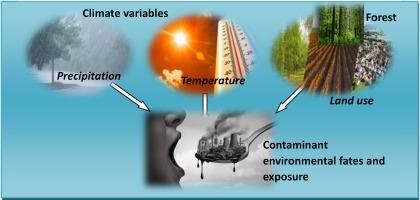气候变化和土地利用对热带流域有机污染物环境命运的影响
IF 8.1
2区 环境科学与生态学
Q1 ENVIRONMENTAL SCIENCES
引用次数: 0
摘要
有机污染物,如多溴联苯醚、二恶英、呋喃、农药以及全氟烷基和多氟烷基物质,具有对人类和环境造成危害的倾向,其中许多目前在环境中普遍存在。利用多媒体模型对影响这些有机物的环境命运和危害潜力的因素进行了评价。这些因素包括气候条件、土地利用和化学性质。在本研究中,利用多媒体模型RioShed对发展中国家热带流域在不同气候和土地利用情景下,一些已知的持久性有机污染物以及一些持久性较低和极性较强的农药的大气远程输送潜力(LRTPa)、总体持久性(Pov)和十年区间浓度进行了评估。降水变化对灾害结果的影响大于温度变化。然而,在所有评估的气候变化中,至少有一种潜在危害增加,即LRTPa和/或Pov。例如,当降水增加时,LRTPa和Pov普遍分别减小和增大,而当降水减少时,结果则相反。然而,当森林在景观中的比例增加时,气候变化的影响要么被缓和,要么被抵消。这些发现对热带地区有机污染物的管理和控制具有重要意义。本文章由计算机程序翻译,如有差异,请以英文原文为准。

Climate change and land use impacts on the environmental fates of organic contaminants in a tropical watershed
Organic contaminants, such as polybrominated diphenyl ethers, dioxins, furans, pesticides, and per- and polyfluoroalkyl substances, have the propensity to cause human and environmental harm, and many of these are currently ubiquitous in the environment. Evaluations of factors influencing the environmental fates and hazard potentials of these organics are accomplished using multimedia models. Climate conditions, land use, and chemical properties are among those factors. In this study, the multimedia model RioShed was used to evaluate the atmospheric long-range transport potential, (LRTPa) overall persistence (Pov), and ten-year compartmental concentrations of some known persistent organic pollutants, as well as some less persistent and more polar current use pesticides, in varying climate and land use scenarios, applied to a tropical watershed, in a developing country. Precipitation changes were more influential on hazard outcomes than temperature changes. However, for all evaluated climate changes, there were consequential increases in at least one hazard potential – LRTPa and/or Pov. For example, when precipitation increased, LRTPa and Pov generally decreased and increased, respectively – the opposite outcome occurred when precipitation decreased. However, when forest proportion in the landscape increased, the effects climate changes were either tempered or countered. These are important findings for the management and control of organic pollutants in tropical regions.
求助全文
通过发布文献求助,成功后即可免费获取论文全文。
去求助
来源期刊

Chemosphere
环境科学-环境科学
CiteScore
15.80
自引率
8.00%
发文量
4975
审稿时长
3.4 months
期刊介绍:
Chemosphere, being an international multidisciplinary journal, is dedicated to publishing original communications and review articles on chemicals in the environment. The scope covers a wide range of topics, including the identification, quantification, behavior, fate, toxicology, treatment, and remediation of chemicals in the bio-, hydro-, litho-, and atmosphere, ensuring the broad dissemination of research in this field.
 求助内容:
求助内容: 应助结果提醒方式:
应助结果提醒方式:


